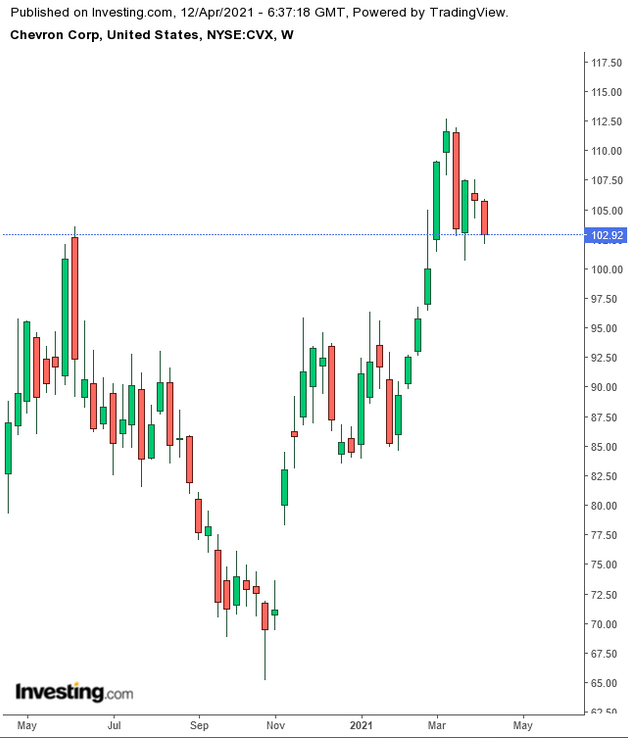After a devastating 2020, during which oil demand plummeted as the pandemic escalated, big oil stocks have become a great recovery bet for investors. The Vanguard Energy Index Fund ETF (NYSE:VDE)—whose top 10 holdings include ExxonMobil (NYSE:XOM), Chevron (NYSE:CVX) and Phillips 66 (NYSE:PSX)— have surged 29% this year versus the S&P 500’s 9% expansion during the same period.
The latest trend in oil markets suggests that energy stocks have passed the worst of the pandemic-driven crisis as oil demand slowly increases, fueled by both OPEC+ production cuts and countries reopening after COVID-19 lockdowns, reviving industrial production and bringing cars back onto roads.
Even after the recent powerful run, some of the largest oil stocks could still be offering some upside if we assume that the global economy is about to enter a multiyear of massive expansion as the vaccine rollouts accelerate and the coronavirus becomes contained. Keeping this theme in mind, we're focusing on the two largest US producers—Exxon and Chevron—to see which “super major” could prove a better bet in this environment.
1. ExxonMobil
Among US oil and gas supermajors, Exxon was the least-favored oil stock during the pandemic. In early 2020, its shares were massively beaten down when the company was forced to roll back its ambitious expansion plans after the price of oil collapsed in the early part of the year.

While announcing its fourth-quarter earnings in January, Exxon reported its first annual loss in at least three decades, taking a $19-billion impairment charge, with cash flows swinging to negative $20 billion after dividend payouts were included.
That blow had a more devastating impact on Exxon when compared with other energy giants. It turned the company’s expansionist approach—which was based on huge spending to find more oil and gas at a time when the world is moving to clean sources of energy—upside down.
Besides the pandemic-triggered crash in oil markets, Irving, Texas-based Exxon announced it was laying off thousands of employees, and was dropped from the 30-component, blue-chip Dow Jones Industrial Average in late August, after its market value plunged.
During that period, investors were extremely doubtful about its ability to continue paying dividends. After facing what has clearly been the most challenging year in the company's history, CEO Darren Woods has come up with a plan to win Wall Street’s confidence.
Woods' new blueprint for XOM diverts capital spending to advantaged assets with the highest potential future value, including developments in Guyana and the US Permian Basin, targeted exploration in Brazil and chemicals projects to grow high-value performance products.
Investors seem to be cozying up to this turnaround strategy. The company’s stock price, which closed on Friday at $55.87, is up more than 60% in the past six months. Exxon pays a quarterly dividend of $0.87-a-share with an annual yield of 6.2%.
In a note last week, Goldman Sachs said Exxon is a better buy based on its long-term earnings revision story, which hinges on its Chemicals’ division and spending control measures. Goldman has a $65 target on Exxon. That's 16% above where the stock closed on Friday.
2. Chevron
Chevron is emerging from the wreckage of 2020 in much better shape than Exxon. What rescued the San Ramon, California-based energy giant were its tight controls over spending as well as doing away with major expansion plans during the past five years.

That strategy kept CVX shares well-supported during the past five years, during the period when Exxon saw its share value plunge. Still, there's no escaping the reality that while Chevron’s strategy of holding spending on a tight leash was correct, it also needed to borrow heavily to pay its dividends after the collapse in oil prices last year led to tight refining margins.
In 2020 Chevron paid out more cash in dividends ($9.7 billion) than it spent on capex ($8.9 billion). That hasn’t happened for Chevron in at least the past 30 years, according to data compiled by Bloomberg. In addition, last year’s acquisition of Noble Energy, a deal that closed in October, pushed Chevron's leverage ratio to 23%, the highest year-end level since 2002.
According to Goldman, Chevron’s multiyear outperformance when compared to Exxon, has run its course. The firm's analysts, led by Neil Mehta, wrote in a note to clients:
“We continue to have a positive view of the balance sheet, dividend sustainability, growth outlook in the Permian, and free cash flow from the Australia LNG assets.”
But they noted that after Chevron’s relative outperformance over the last few years, the stock now trades at a premium to peers on several metrics, including enterprise value to debt-adjusted cash flow, as well as price to earnings.
After gaining 22%, Chevron stock traded at $102.92, with an annual dividend yield of about 5%. The company pays $1.29 a share quarterly.
Bottom Line
Until last year, in the energy space, Exxon was a riskier bet than Chevron. But the US's largest oil giant has now succeeded at changing that perception by re-balancing its portfolio and pursuing major cost cuts.
After this turnaround, coupled with an improved oil price outlook, Exxon stock is a better buy, and the company is in a better position than it was last year to save its $0.87-a-share quarterly dividend.
